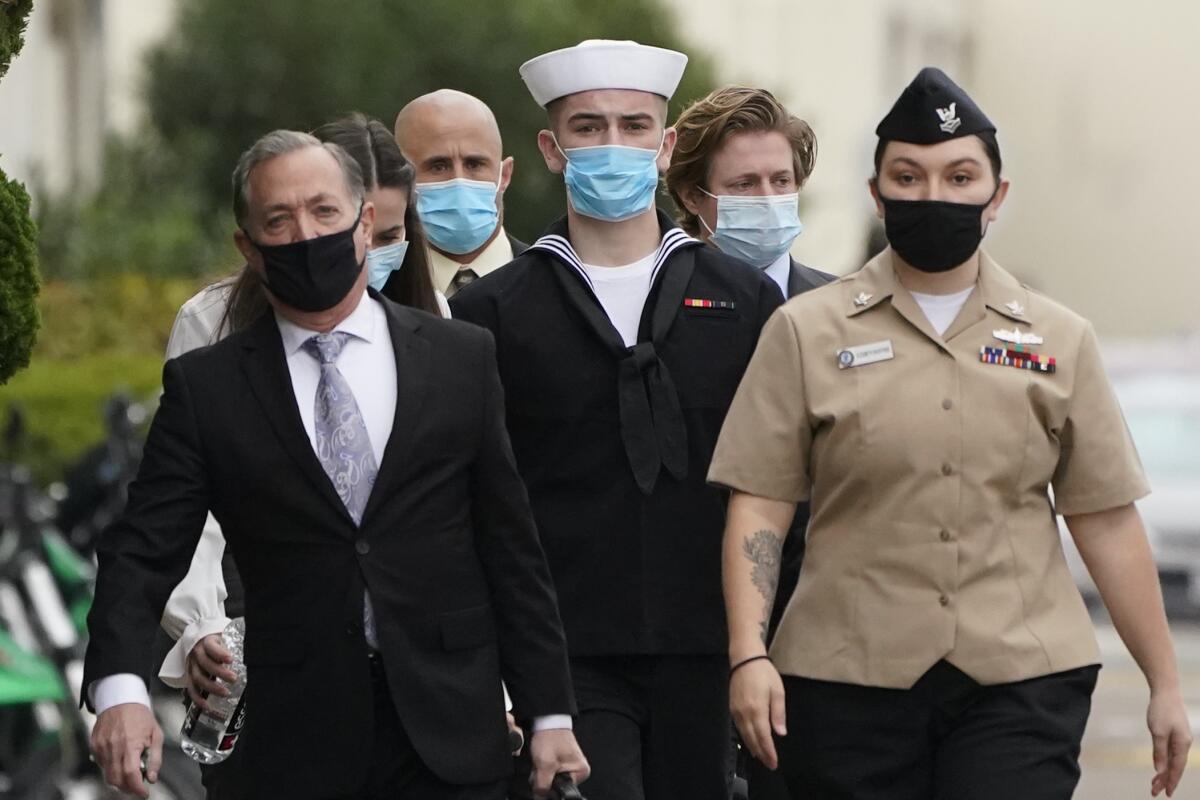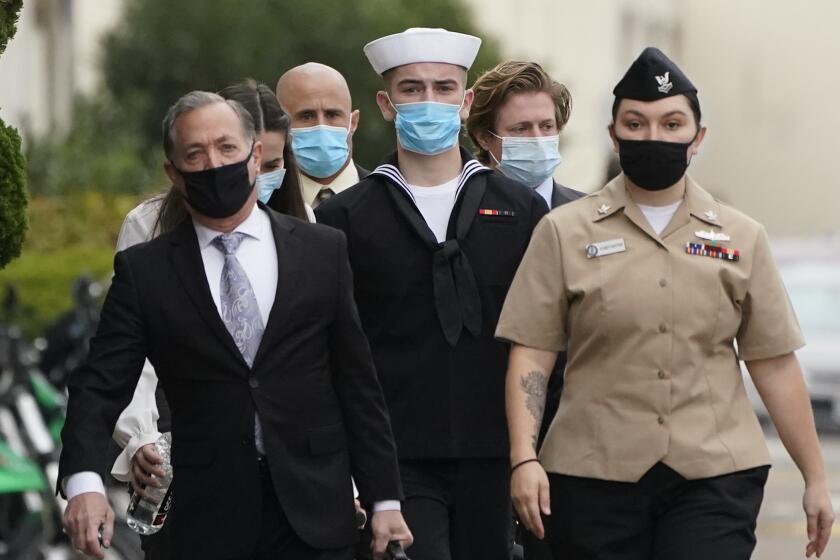Witnesses testify to seeing sailor at scene of Navy ship fire and hearing apparent admission

- Share via
SAN DIEGO — As he was being taken to the brig in August 2020, the Navy’s prime suspect in the devastating arson fire on the amphibious assault ship Bonhomme Richard muttered something striking under his breath, a Navy police officer testified in a San Diego military courtroom Tuesday.
“I’m guilty, I guess I did it — it had to be done,” Seaman Ryan Mays allegedly said upon learning he was going to the brig in connection with the fire, according to Navy Master-at-Arms 1st Class Carissa Tubman, whose job was to escort the sailor. Mays’ defense team contends the statement was made sarcastically.
Tubman’s testimony came at the end of the second day of Mays’ preliminary hearing at the Naval Base San Diego courthouse, just steps from where his former ship, the Bonhomme Richard, burned for over four days, starting on July 12, 2020.
The proceedings, known as Article 32 hearings, function in the military system much as a grand jury functions in civilian courts, except for two key differences: The defense, not just the prosecution, gets to present evidence and call witnesses, and instead of a jury, a lone hearing officer takes the evidence and testimony.
Capt. Angela Tang, the Navy judge serving as Mays’ hearing officer, will review the evidence once the hearing is over and make a recommendation on whether to proceed to court-martial. That decision rests with the 3rd Fleet admiral in San Diego, Vice Adm. Stephen Koehler.
The preliminary hearing opens in the military case against Seaman Ryan Mays, accused of setting a fire that devastated the USS Bonhomme Richard in san Diego.
Mays, 20, is charged with the willful hazarding of a vessel and aggravated arson, charges that his civilian defense attorney, Gary Barthel, said carry a possible life sentence if he’s convicted.
Mays denies setting the fire.
Navy prosecutors allege Mays was disgruntled with the Navy after dropping out of Basic Underwater Demolition/SEAL training, known as BUD/S, and then finding himself working as a deck seaman on the 844-foot vessel. Two senior enlisted sailors who served on the Bonhomme Richard with Mays testified Tuesday that the young sailor had a reputation on the ship as someone with a bad attitude who often found himself in trouble for uniform and grooming infractions.
Petty Officer 3rd Class Kenji Velasco, a key prosecution witness, was on watch in the upper vehicle storage area, at the top of the ramp leading down into the lower vehicle storage area, or “lower V,” the morning of the fire. He testified Tuesday that he saw Mays walking down the ramp into the lower V — where investigators say the fire started — just minutes before sailors first saw smoke that Sunday morning. Mays was carrying a metal bucket by the bottom instead of its handle, and it appeared to be heavy, Velasco said.
Velasco was at his post all morning, never left, and saw Mays from about five to 10 feet away, he said in court.
Defense attorneys, however, pointed out inconsistencies in Velasco’s story throughout the investigation. Lt. Cmdr. Sharlena Williams, one of Mays’ military defense attorneys, questioned Velasco at length about how his story changed as Navy Criminal Investigative Service agents interviewed him almost every day in the immediate aftermath of the fire. NCIS interviewed Velasco on four consecutive days beginning July 20, then resumed its interviews with the sailor in August, Williams said.
At first, according to interview transcripts, Velasco said he did not recognize the sailor he saw that morning, Williams said in court. As agents continued to question him, Williams said, Velasco became more certain it was Mays he saw. Velasco, in an interview with defense attorneys ahead of Tuesday’s hearing, told them he felt “pressured” during the investigation, Williams said.
Velasco attributed changes in his story to nervousness after the fire. He said he wanted to be certain it was Mays he saw that day, so he later reviewed the duty logs. When he saw Mays’ name on the roster, he knew it was the sailor he’d seen.
He said he’s now “100%” sure it was Mays he saw go into the lower V.
Williams suggested Velasco also felt the pressure as a potential suspect himself, noting other sailors had begun to call him “fire-starter.”
On Aug. 21, after several interviews with NCIS, Velasco told investigators for the first time that Mays had admitted to being in the lower V. On July 16, 2020, Mays told Velasco he was the person Velasco saw going into the lower V the morning of the fire. According to Velasco, the admission came while the two were talking with a group of Bonhomme Richard sailors outside the base theater.
Mays’ alleged admission was not heard by the other sailors at the theater that day, Williams said.
Al Porter, a senior NCIS investigator who interrogated Mays, also testified Tuesday. Porter said Mays lied about a few things during his interview — such as his time in SEAL training and a relationship with a female sailor — which Porter said were clues that the young sailor would lie about other things too.
Prosecutors played clips from Porter’s interrogation with Mays, in which the sailor said he didn’t like the “fleet,” used a homophobic slur, and said that he “loved” being in SEAL training.
Porter, who served as a Navy SEAL in the 1980s, said that during one interrogation, Mays asked him to write him a letter of recommendation to BUD/S.
More to Read
Sign up for Essential California
The most important California stories and recommendations in your inbox every morning.
You may occasionally receive promotional content from the Los Angeles Times.












